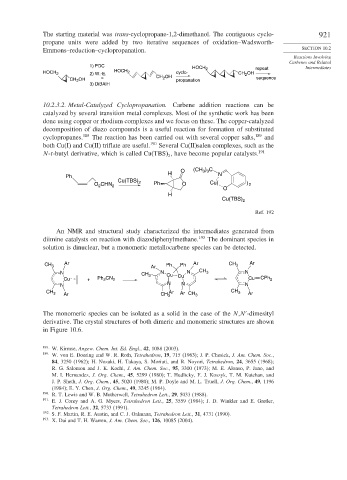Page 945 - Advanced Organic Chemistry Part B - Reactions & Synthesis
P. 945
The starting material was trans-cyclopropane-1,2-dimethanol. The contiguous cyclo- 921
propane units were added by two iterative sequences of oxidation–Wadsworth-
Emmons–reduction–cyclopropanation. SECTION 10.2
Reactions Involving
Carbenes and Related
1) PDC HOCH Intermediates
HOCH 2 repeat
HOCH 2 2) W.-E. 2 cyclo- CH OH
2
2
CH OH CH OH propanation sequence
2
3) DiBAlH
10.2.3.2. Metal-Catalyzed Cyclopropanation. Carbene addition reactions can be
catalyzed by several transition metal complexes. Most of the synthetic work has been
done using copper or rhodium complexes and we focus on these. The copper-catalyzed
decomposition of diazo compounds is a useful reaction for formation of substituted
cyclopropanes. 188 The reaction has been carried out with several copper salts, 189 and
both Cu(I) and Cu(II) triflate are useful. 190 Several Cu(II)salen complexes, such as the
N-t-butyl derivative, which is called Cu(TBS) , have become popular catalysts. 191
2
O (CH ) C
3 3
H N
Ph
Cu(TBS) 2
O CHN 2 Ph O Cu( ) 2
2
O
H
Cu(TBS) 2
Ref. 192
An NMR and structural study characterized the intermediates generated from
diimine catalysts on reaction with diazodiphenylmethane. 193 The dominant species in
solution is dinuclear, but a monomeric metallocarbene species can be detected.
Ar Ar Ar
CH 3 Ph Ph CH 3
Ar
N CH 3 N Cu Cu N CH 3 N
Cu + Ph 2 CN 2 Cu CPh 2
N N N N
Ar CH 3 Ar CH 3
CH 3 Ar CH 3 Ar
The monomeric species can be isolated as a solid in the case of the N,N -dimesityl
derivative. The crystal structures of both dimeric and monomeric structures are shown
in Figure 10.6.
188 W. Kirmse, Angew. Chem. Int. Ed. Engl., 42, 1088 (2003).
189
W. von E. Doering and W. R. Roth, Tetrahedron, 19, 715 (1963); J. P. Chesick, J. Am. Chem. Soc.,
84, 3250 (1962); H. Nozaki, H. Takaya, S. Moriuti, and R. Noyori, Tetrahedron, 24, 3655 (1968);
R. G. Salomon and J. K. Kochi, J. Am. Chem. Soc., 95, 3300 (1973); M. E. Alonso, P. Jano, and
M. I. Hernandez, J. Org. Chem., 45, 5299 (1980); T. Hudlicky, F. J. Koszyk, T. M. Kutchan, and
J. P. Sheth, J. Org. Chem., 45, 5020 (1980); M. P. Doyle and M. L. Truell, J. Org. Chem., 49, 1196
(1984); E. Y. Chen, J. Org. Chem., 49, 3245 (1984).
190 R. T. Lewis and W. B. Motherwell, Tetrahedron Lett., 29, 5033 (1988).
191
E. J. Corey and A. G. Myers, Tetrahedron Lett., 25, 3559 (1984); J. D. Winkler and E. Gretler,
Tetrahedron Lett., 32, 5733 (1991).
192 S. F. Martin, R. E. Austin, and C. J. Oalmann, Tetrahedron Lett., 31, 4731 (1990).
193
X. Dai and T. H. Warren, J. Am. Chem. Soc., 126, 10085 (2004).

